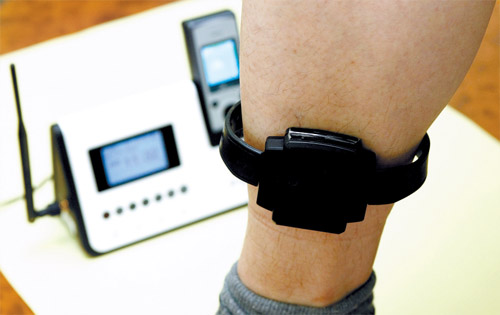Korea clamps down on sexual violence

Cho Du-sun was a repeat offender who served a total of 10 years and four months in jail under charge of injury resulting from rape back in 1983 and 14 other offenses.
After he was released, he lived freely, with no restrictions or supervision. But on the morning of Dec. 11, police say Cho kidnapped a girl, referred to by the pseudonym Na-young in this article, who was on her way to school in Ansan, southwest of Seoul.
The 57-year-old Cho took the girl to a toilet in a nearby church, strangled and beat her unconscious, then raped her. The girl suffered devastating internal injuries, losing 80 percent of her colon and genital organs. She underwent eight hours of surgery but many of her lower organs remain completely dysfunctional.
The rapist was sentenced to 12 years in prison. After that, he will have to wear a traceable electronic anklet for seven years, and his personal information will be made available to the public for five years.
The Korean public was outraged at the sentence, which many say was too light. The court was criticized for being too lenient on Cho because it used a provision in the law that allows courts to reduce punishments for offenders who were under the influence of alcohol when a crime is committed. The court reduced Cho’s sentence because he was “weaker mentally and physically.”
This is not the first case of child sexual assault to incite a public outcry. The rape and murder of an 11-year-old girl in Yongsan District in 2006 shocked and angered the nation. The nation was thrown into turmoil again when two young girls, Hye-jin and Ye-seul, aged 11 and 8, were kidnapped, sexually assaulted and strangled in Anyang in 2007.
When the cases came to light, both the government and the opposition parties proposed countless measures against sexual offenders, but they, too, eventually grew silent.
Meanwhile, an increasing number of children became the victims of sexual abuse. The number of children under 13 years of age who were the victims of sexual abuse increased nearly twofold over a three-year period, from 738 cases in 2005 to 1,220 in 2008, according to the statistics from the National Police Agency.
To discourage sexual offenders from becoming repeat offenders, Korea began using an electronic anklet monitoring system in September 2008. The anklets monitor the movements of convicted sexual offenders around the clock. Currently, a total of 162 criminals are being tracked, including seven sexual offenders convicted of committing crimes against children under the age of 13.
The operation is overseen by the Seoul Probation and Police Office in Hwigyeong-dong, Dongdaemun District. A large screen in the middle of the office shows a map of Korea and the criminals’ locations are indicated by a small green light. The green light turns from yellow to red and an alarm goes off whenever the anklet is a certain distance away from the criminal or when the battery dies. The alarm also goes off when criminals try to remove the anklet. The system is updated every three minutes.
“Criminals cuffed with traceable anklets feel pressured, which we hope will prevent them from committing a second offense,” Hong Jung-won, head of the Seoul Probation and Police Office, said.
Among the 498 criminals with anklets, only one has been convicted for the same crime twice since the law went into effect in September last year. Thanks to the tracking device, the offender was caught by the police within 20 hours.
But Hong added that “only a few offenders are barred from going near schools or specific areas, so the device has limitations as a means of preventing recidivism.”

An electronic tracking anklet
Among the countless measures proposed for sexual offenders, the electronic anklet system was the one adopted most quickly. When the system was first proposed in 2005, the government received heavy criticism from numerous civic groups that said it would violate offenders’ human rights. But right after the Yongsan rape and murder case of 2006, the public gave its support to the system and the government, which had up to that point been slow in implementing tougher restrictions for child sexual offenders, began introducing new bills to the National Assembly. The bill on the electronic anklet monitoring system was signed in April 2007. Implementation of the law was moved up two months ahead of schedule when the Ansan rape and murder case arose.
In order to minimize the infringement on the offender’s human rights, the device had to be light and small, and the government spent up to 8 billion won ($6.8 million) to develop an appropriate device.
Another issue that arose with these cases was the question of whether to make public the identities of people convicted of murder, rape, robbery or kidnapping. When a bill was proposed in 2004, the National Human Rights Commission of Korea had strong objections to it, again, because they believed that publicizing the identities of these people would violate their human rights. But the bill was passed in August 2007 after the 2006 Yongsan District case.
In June this year, it was announced that the identities of criminals (name, photo and address) would be available online beginning next year.
In reality, most of the measures that have been announced have been delayed due to insufficient funds. Another reason is that momentum tends to decrease after the initial fury over a crime begins to dissipate.
Advocates for the victims of sexual violence point to another problem.
“The anger toward the offender from the general public is so high that most measures are overly focused on strengthening punishments,” Lee Yun-sang, head of the Korea Sexual Violence Relief Center, said.
The reporting rate for cases of child sexual violence is relatively low compared to other crimes, she said, adding that she hopes to see more measures to facilitate reporting that also protect the victims once they report a crime. The current reporting rate is slightly over 6 percent, she said.
Meanwhile, numerous women’s organizations have rolled up their sleeves to enact a provision that would nullify the Korean law that says the court can reduce the sentences of those who commit crimes while intoxicated.

The Seoul Probation and Police Office in Hwigyeong-dong, Dongdaemun District, tracks the locations of criminals 24 hours a day, seven days a week. [JoongAng Ilbo]
The prosecution said it was problematic that the law is applied to one in every three sexual assault cases but is rarely applied to homicides.
“Modifying the law is important but changing the lenient social convention toward sexual assault is just as crucial,” Lee said.
Things are starting to change. Yoon Duk-kyung of the Korean Women’s Development Institute said, “Many of the laws began to change after the Hye-jin and Ye-seul case of 2007.”
New measures such as having separate prisons for sexual offenders, mandating up to 90 hours of education for sexual offenders convicted of crimes against children under the age of 13, or providing psychiatric help for those with mental disabilities are currently being tested.
Additional reporting by Yim Seung-hye, contributing writer.
By Kim Jung-soo [estyle@joongang.co.kr]










with the Korea JoongAng Daily
To write comments, please log in to one of the accounts.
Standards Board Policy (0/250자)